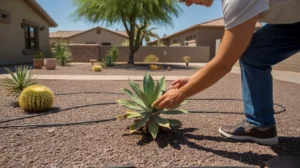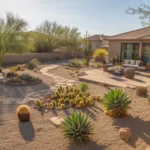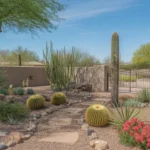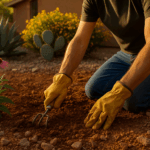As we reach the peak of summer in Queen Creek, it’s the perfect time to pause and reevaluate how your yard is performing. By mid-summer, you’ve likely seen which plants are thriving, where your irrigation may need adjusting, and how your soil is holding up to the intense heat. Taking stock now allows you to make smart course corrections and help your yard thrive, not just survive, through the rest of the season. Here’s how to conduct a mid-summer yard reevaluation in Queen Creek for better results.
Assess Your Plants’ Health and Hydration
Start by carefully observing each plant in your yard, looking for signs of stress, sunburn, or overwatering. In Queen Creek’s hot, dry summers, it’s common for even desert-adapted plants to show some wilting or leaf drop. However, extensive browning, crispy leaves, or mushy stems can indicate more serious issues like inadequate hydration or poor drainage.
For trees and shrubs, check the soil moisture at the root zone by digging down a few inches. The soil should be slightly damp but not soggy. Adjust your irrigation schedule if needed to maintain consistent moisture without waterlogging the roots. Remember that established trees, even desert species like palo verde or mesquite, still need deep watering every 7-10 days in summer.
Succulents like agave and cacti are more prone to overwatering than underwatering. If you see yellowing, translucent leaves or black spots, cut back on watering frequency and ensure the soil drains rapidly. Succulents store water in their leaves and stems, so they can tolerate periods of drought better than consistently wet feet.
Evaluate Your Irrigation Coverage and Efficiency
Mid-summer is an ideal time to audit your irrigation system and check for any leaks, clogs, misaligned heads, or coverage gaps. Run each zone for a few minutes and watch how the water is distributed. Are any areas being missed or oversprayed? Are you seeing runoff or puddling? These are signs that your irrigation needs adjustment.
In Queen Creek, drip irrigation is often the most efficient choice, delivering water directly to the root zone of plants. If you have older spray heads, consider converting them to drip, especially in planted areas. Sprays can lose a lot of water to evaporation in our intense summer heat. Drip allows you to fine-tune the watering for each plant’s specific needs.
Also check your irrigation controller settings. Many controllers have a seasonal adjustment feature that lets you increase or decrease the watering time by a percentage across all zones. In peak summer, you may need to bump this up to 100-120% to keep up with heat and evaporation. Just be sure to dial it back down as temperatures cool off in fall.
Analyze Your Soil Quality and Mulch
Healthy soil is the foundation of a thriving yard, but our Queen Creek clay soils can be tricky. Clay holds moisture and nutrients well but can easily compact, impeding root growth and drainage. Extreme summer heat can bake the soil surface into a hard, water-repellent crust.
If you haven’t recently, conduct a simple soil test to check the pH and nutrient levels. Many desert plants prefer slightly alkaline soil, but if the pH is over 8.0, you may need to amend with sulfur to bring it down. Our clay soils are often low in nitrogen and phosphorus, so a light application of slow-release fertilizer can give plants a mid-summer boost.
Mulching is essential for regulating soil moisture and temperature. By mid-summer, your spring mulch layer may have thinned out. Maintain a 3-4 inch layer of organic mulch, like bark or wood chips, around trees, shrubs, and perennials. For succulents and cacti, use a 1-2 inch layer of inorganic mulch like gravel or decomposed granite. Avoid mounding mulch against plant stems or tree trunks, which can trap moisture and invite pests and disease.
Tackle Weeds and Pests Proactively
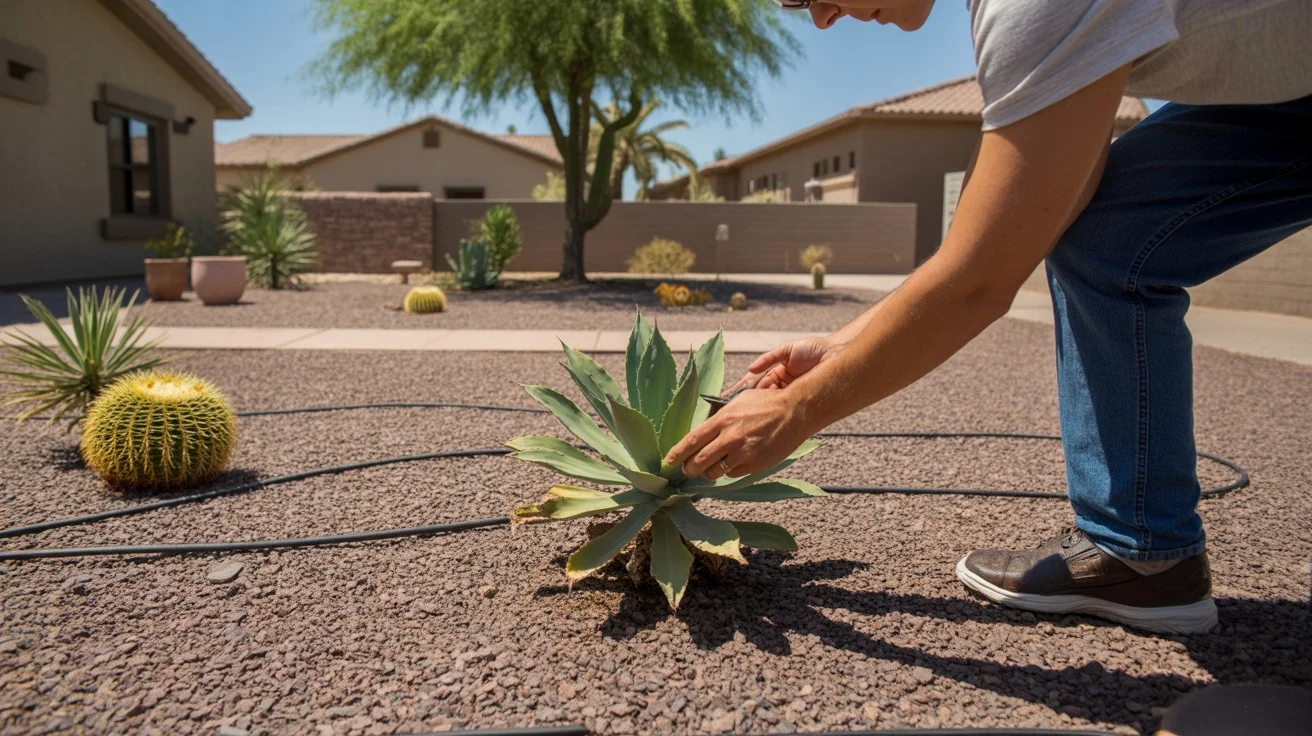
Summer monsoon rains can trigger a flush of weed growth in Queen Creek yards. Weeds compete with your desired plants for water, nutrients, and root space, so it’s important to remove them promptly. After a rain, hand-pull weeds or spot-treat with a post-emergent herbicide. Applying a pre-emergent in early summer and again in early fall can prevent many weed seeds from sprouting.
Our hot, dry summers can also drive certain pests to seek moisture and shade in the yard. Check plants for signs of spider mites, whiteflies, or scale insects, which can proliferate in heat-stressed plants. A strong spray of water can dislodge many pests, or you can spot-treat affected areas with insecticidal soap or neem oil. Avoid broad-spectrum insecticides that can harm beneficial predators like ladybugs and lacewings.
Rabbits and rodents may also be more prevalent in summer, chewing on tender new growth. Protect young trees with trunk guards and consider temporary fencing around vegetable beds or susceptible shrubs. Removing yard debris and sealing entry points to sheds or under decks can discourage rodents from taking up residence.
Plan Ahead for Fall Planting and Projects
While mid-summer isn’t the ideal time for major yard installations in Queen Creek, it is a great time to start planning for fall projects. Autumn brings milder temperatures and a second planting window before winter. Take note of any bare spots or lackluster areas in your summer yard that could use a refresh come October.
Consider additions like outdoor lighting to extend your enjoyment of the yard into the evening hours. Sketch out ideas for new seating areas, pergolas, or water features that could make your yard more functional and inviting. Tackling these projects in fall will allow you to relish them all winter and spring long.
Remember, a clay soil yard is always a work in progress, especially amid Queen Creek’s intense summer conditions. By pausing to reevaluate mid-season and make informed adjustments, you can help your yard thrive, not just survive, year after year. With a little TLC and proactive planning, your Queen Creek yard can be a vibrant, resilient oasis through every season.

